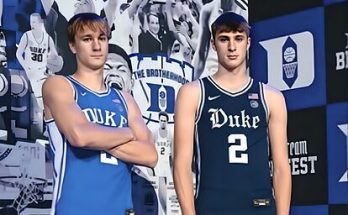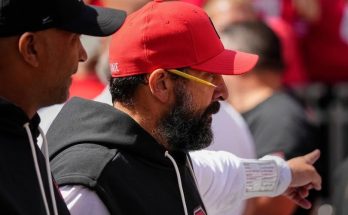REPORT: The Heat are actively shopping Duncan Robinson’s expiring $19.8 million deal, and it’s quietly become one of the NBA’s most talked-about contract situations. According to Evan Sidery, Miami is keen to shift his sizable cap hit—but interest remains lukewarm owing to a mix of on‑court inconsistency and long-term salary obligations.
Robinson’s situation is fascinating. His five-year, $90 million deal, signed in 2021, represented the largest contract ever awarded to an undrafted player. At the time, it was a bold statement of intent from both Miami and Robinson. Since then, though, his production hasn’t reliably matched that investment. Last season saw glimpses of brilliance—he averaged 12.9 points and shot 39.5 percent from three—but head-scratching dips in volume and efficiency often followed . His deep threat remains a valuable skill, especially in today’s three-point-fast NBA, but defensive limitations and inconsistent form have made teams cautious.
What makes Robinson especially tricky to move is the dollar figure—and the way it’s structured. For the upcoming season, he’s owed $19.8 million, but only $9.8 million is fully guaranteed . The remainder kicks in only if Miami wins a title or certain conditions are met. On paper, that creates wiggle room—but the financial burden is still hefty for any team considering a package deal.
Teams see both upside and risk. On one hand, Robinson is one of Miami’s most reliable three-point shooters when he’s hot—he’s even the franchise’s all-time leader in made threes . On the other, his dips in usage and defensive shortcomings can limit his floor-to-floor value. Combined with his contract, it’s a deal that demands serious thought from interested suitors.
Why is Miami so eager to move him now? The Heat find themselves in a transitional phase. They’re striving to fine-tune depth and flexibility around their core of Jimmy Butler and Bam Adebayo. Their offseason ambitions target upgrades that blend two-way playmaking, rim protection, and forward versatility. But to get there, Miami needs to offload salary and reallocate assets—but not at the expense of losing useful rotation pieces .
It’s clear Miami sees Robinson as both a salary-matching piece and a complementary shooter—a player who could help another team add space—but they need to find the right buyer. Previous trade efforts have had modest traction. Back in February 2023, outlets like HoopsHype reported the Heat had soured on discussions involving Robinson, with teams demanding multiple first-round picks just to absorb the contract . Again, this year, rumors surfaced—Bob Marks of ESPN said teams “wouldn’t even touch his contract” during the DeMar DeRozan talks . More recently, Bleacher Report’s Marc Stein noted Miami continues to shop Robinson “without success,” pointing to declining averages (6.9 points on 36.8 percent 3‑point shooting) and the finger surgery that sidelined him since January .
The underlying narrative feels familiar: an elite shooter whose value has been undercut by performance and money. Yet there’ve been moments of clarity. During injury-depleted periods, Robinson stepped up, playing as many as 29 minutes per night, shooting nearly 50 percent from the floor and emerging as a secondary playmaker . Those flashes reinforce why the contract remains surprisingly coveted—if Miami can find a way to make it part of a broader offer rather than a solo add.
Potential fits around the league might include playoff-hungry teams seeking space in their rotations—perhaps clubs like Portland, New Orleans, or even Dallas, but only if the financials align. The key will be packaging Robinson with draft capital or other salary to make his contract palatable. Without that, the narrative falls flat: too much money for inconsistent output.
From the Heat’s perspective, trading Robinson opens up choices. They could pivot to someone with more two-way impact, such as Myles Turner, whose rim protection and defensive presence could significantly boost Miami’s interior toughness . Or they might look at multi-dimensional guards who can both shoot and create. Either way, shedding $19.8 million gives them breathing room to chase those upgrades.
Yet that doesn’t mean they’ll lose their sharpshooter. Robinson’s ability to stretch the court is still valued in Erik Spoelstra’s system, especially when spacing can open lanes for Butler and Adebayo. Removing him carries a risk if his replacement can’t match that perimeter impact.
For Robinson personally, it’s a crossroads. On one hand, a fresh environment might reignite his shot and offer a reset. On the other, it could mean a diminished role and less stability than he’s enjoyed in Miami. It won’t be an easy adjustment for a player so tied to one franchise’s identity.
So what comes next? Expect Miami to continue circulating Robinson’s name in trade conversations—especially as the opening of free agency draws near and the Heat dig deeper into trade-market dynamics. Whether by mid-summer they find a match remains uncertain. But one thing’s clear: this is about more than just one player. It’s emblematic of modern NBA moves—financial flexibility wrapped in performance uncertainty. The Heat are trying to ride the fine line between keeping a valuable skill-set and redirecting resources toward a higher ceiling.
For fans and pundits, the question becomes: what’s Robinson’s true trade value? Is he still worth $20 million in a league where shooting is prized—if he can stay healthy and efficient? Or has his inconsistent form and steep contract essentially priced him out of being a must-add? And for Miami, the bigger gamble looms: can they turn this financial shuffle into an upgrade that moves the needle?
In league-wide terms, the Robinson saga illustrates how contract structures now shape team-building more than ever before. A move like this could ripple—freeing up room for strategic targets, impacting luxury tax considerations, and giving Miami a nimble roster heading into the next window. That’s why both sides are running the numbers hard: Miami to see which pieces they can pry loose, and Robinson to see where he might find a place that values him at the right price.
As it stands, the $19.8 million figure looms over all conversations. It’s big money, even with the partial guarantee in 2025–26. Most teams see a mid-tier shooter at best; others see a specialist whose contract won’t dictate their long-term direction. The negotiation landscape will likely involve draft assets—Miami will want picks to sweeten any package, while prospective teams will insist on salary matching via draft capital or role players.
For Robinson, the offseason holds two critical storylines:
- First, whether he can rebuild momentum—health permitting. His finger surgery took him off the court, but if he returns firing, that could help reset the narrative around his contract.
- Second, where he lands. A move to a team that can maximize his shot-making would benefit both parties, but only if the dollars align.
Meanwhile, the Heat are watching open markets, assessing who’s willing to trade draft picks or even young talent to absorb cap space. Names like Turner or defensive bigs are being floated; Miami hopes reallocating Robinson’s salary sets up those moves.
In the long view, this tells us a lot about modern roster construction: elite shooting is valuable, but dollars talk. Finances have become a major asset in trades—maybe more so than young talent or role players. That’s why Miami is leaning into the financial architecture of Robinson’s contract, seeking leverage in both competition and cost.
Ultimately, the biggest question is whether Robinson is a trade-deadline throw-in or a centerpiece of a balanced deal. If he’s central, Miami could finally land the defensive or playmaking upgrade they crave. If he’s expendable, they may just free cap — but risk letting go of a veteran specialist for nothing. And for Robinson, recalibration will come swiftly: a new team, a new system, and renewed expectations.
For now, though, this contract remains the fulcrum. The Heat are pitching it as an opportunity; other teams are wary. Whoever blinks first—or offers the balance of capital and opportunity—might shape the next phase for both Miami and Duncan Robinson.
The offseason is young, but the Robinson narrative is already one of the more compelling financial chess matches in the league. Keep an eye on it—this move has ripple effects for cap design, team flexibility, and the value of perimeter shooting in an increasingly analytics-driven age.



